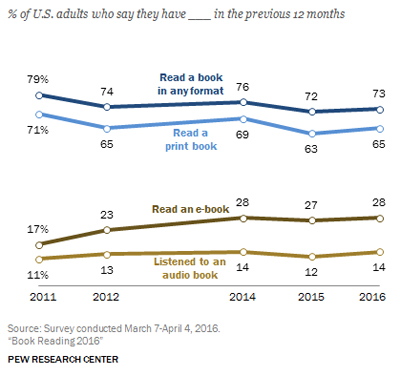Americans still prefer books they can hold in their hands, the New York Times reported early this month.
That’s good news for those of us who would like to autograph books for eager readers, or pass them along to grandkids or great-grandkids. And nothing beats a book whose spine you can read if you’re perusing a neighbor’s shelves to see what their reading habits are, or a book whose page you can dog-ear down before putting it on the night table and turning out the light. (Of course, if it’s “War and Peace,” you may be putting it down not because you’re sleepy, but because your wrists ache.)
On the other hand, there’s something to be said for reading or hearing about an interesting new book and in a few minutes having it on your Kindle or tablet or desktop, probably at less expense than having a hard copy plod to you in the mail two days or so later.
And for those like me who are “publishing” short stories in obscure literary magazines that friends are unlikely to buy, online reading is a godsend. I’ll get to the exhortation in just a moment.
The Times’ story drew from a Pew Research Center study that found 38 percent of Americans said they read books “exclusively in print.’ Another 28 percent were reading a combination of digital and print books.
Using a slightly different measure, Pew found that two-thirds of Americans (65%) said they’d read a print book in the last year, compared to 28% who’d read an e-book, and 14% who’d listened to an audio book. All those figures had changed only marginally in the last two years.
I’ve begun this website and blog in hopes of building an audience for my writing that may someday help me persuade a publisher to take on my unpublished novel or my two unpublished novellas. I’m just shy of a dozen short stories accepted by various literary magazines. You can poke around, get a taste of any of them and read the whole story if you like the flavor. Look under Short Stories in the menu bar at the top, or click on the right-hand-side icon to read Strawberries, my most recently-accepted piece.
I’m also trying to learn more about what people like you want to read, by asking your reaction to some works in progress. You’ll find one I’ve been working on this week, Gigolo, if you click on the Help Wanted icon to the right; or pull down Works in Progress from the menu bar — and help me make any or all of them better.
But keep on reading those solid-in-print books, too; someday I’ll autograph one for you.


 The owner of an old-fashioned hardware store has a last look around before anything unsold in his going-out-of-business sale will go to the highest bidder at auction. Published now at the online Canadian literary magazine (click here==>),
The owner of an old-fashioned hardware store has a last look around before anything unsold in his going-out-of-business sale will go to the highest bidder at auction. Published now at the online Canadian literary magazine (click here==>), 